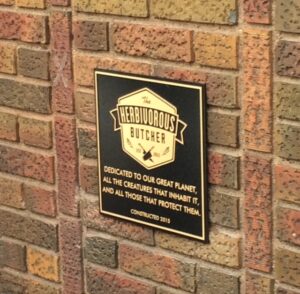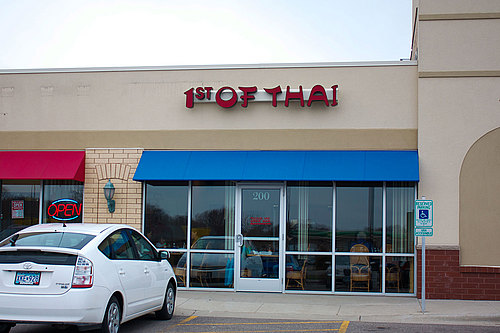On a snowy January Sunday in north Minneapolis, a line snakes out the doors of a shop, continues around the block, up the stairs of an empty retail space, and into a waiting room set up to herd hundreds. I join hip Minneapolis twenty- and thirty-somethings with canvas grocery bags and mason jars of iced coffee mixing with families and groups of middle-aged men in camo and down. At exactly 11 am, the line begins to move and the throngs move closer to their first glimpse and taste of the Herbivorous Butcher.
Owners Aubry and Kale Walch greet the first customers of the day at the world’s only vegan butcher shop. Kale (very appropriately named) wears skintight white jeans, a skinny striped tie, and a white button-down embroidered with the word “butcher”. He bounces giddily along the line playing 70’s hits on a boombox. Reflecting in an article in Eater Magazine on his experience serving Herbivorous Butcher products at a pop-up at the Minnesota State Fair in 2015, Kale enthused: “some of the most hardcore, deep fried-looking people came up and were pleasantly surprised, and they said, ‘I can actually do this.'” The group of devotees in line with me, all willing to wait in line for more than an hour for Herbivorous Butcher products, seem to agree.
Aubry is also in all white with a matching embroidered white button-down and smiles shyly as she offers samples of vegan smoky house barbeque ribs and dairy-free dill Havarti to eager patrons. Employees in butcher’s hats also walk amongst the hoards, handing out samples of herb smoked cheddar, breakfast sausage, and Italian ham. The interior of the shop, gratifyingly warm after the long wait outside, resembles a classic deli, with black and white retro tiling, wooden walls and flooring, and glass displays cases filled with vegan meats, cheeses, and butter. Shelves along the walls display additional vegan goodies including spices, chocolates, and clothing.
Just inside the doors, the owners’ stepfather greets the more than 3000 customers who come through the shop during grand opening weekend. He seems relieved to chat about football for a while rather than continue to discuss the family business, but shares that sixty to seventy percent of the customers at Herbivorous Butcher are meat-eaters like himself. Before snapping back into selling mode, he admits that has had to get used to the idea of trying kooky vegan options for thanksgiving dinners since meeting the owners’ mother five years ago.
A little more than an hour after joining the line, I exit the shop with a haul of Teriyaki Jerky, Chorizo, Spicy Italian Sausage, Smoky House Smoked Barbeque Ribs, Korean Barbeque Ribs, and Bacon. All vegan, of course. The line has grown since I entered the shop, and Kale and Aubry continue to move amongst their adoring crowds giving out samples, playing music, and savoring their success.
The spectacle on that January morning marked the opening of the world’s first vegan butcher shop in Minneapolis. The opening, and the preceding months of Kickstarter campaign work, farmers market pop-ups, and brick and mortar construction were reported widely by the New York Times, NPR’s Weekend Edition, The Huffington Post, and dozens of other media outlets. So how did Herbivorous Butcher become an international media sensation, where do Aubry and Kale fit in the history of fake meat entrepreneurs, and how does vital wheat gluten actually taste when it’s processed into meat-alternatives anyway?
The answers lie in unexpected places.
According to The History of Meat Alternatives, by Akiko Aoyagi and William Shurtleff, until 1790 AD, all written accounts of meat-alternatives come from China. The earliest known reference to tofu appeared in a work titled “Anecdotes, Simply and Exotic” from 965 AD in China, when a frugal magistrate discouraged meat eating amongst his citizenry. Instead, he promoted the consumption of tofu, and referred to it as “mock lamb chops” or “the vice Mayor’s mutton.” By 1790, a meat alternative to poultry was mentioned for the first time in a book of Recipes from the Sui Garden by Yuan Mei, which listed a recipe for mock roast goose.
Outside of China, tempeh was mentioned for the first time as a meat-alternative in a twelve-volume compilation of Javanese tales and teachings from Indonesia in 1815. On November 24th, 1852, nearly a millennium after their conception in China, meat alternatives were mentioned for the first time in the Western world in the New Hampshire Patriot and State Gazette. The newspaper reported: “we learn that a distinguished Grahamite has invented a vegetable sausage. The vegetable sausage has long been a desideratum with the proprietors of vegetarian boarding-houses.” Thus in 1852, the vegetarian meat analogue movement was born in America. By 1892, the New York Times began to report on the trend of meat alternatives, and the word “meatless” was first used when the Times ran an article entitled “A Meatless Feast. Banquet of the New-York Vegetarian Society.” In 1893, the Times coined yet another term: “meat substitutes” in an article titled “Lectures on Cooking.”
Around the same time The New York Times began reporting on meat substitutes, another pair of siblings, very unlike Kale and Aubry Walch, were in the midst of developing the first successful commercial meat alternative in the Western World. According to a profile of Kellogg Corporation founder Will Keith Kellogg in Entrepreneur, Dr. John Harvey Kellogg, Will Keith’s brother, was a Seventh-day Adventist, physician, author, and inventor. Seventh-day Adventists practice vegetarianism, and John Harvey experimented with meat alternatives in an attempt to help his family adhere to the faith’s diet strictures.
John Harvey Kellogg became superintendent of Battle Creek Sanitarium, an alternative health resort, in 1876 and convinced his brother Will Keith Kellogg to join him as bookkeeper and inventing partner. John Harvey believed strongly in vegetarianism, and enlisted Will Keith to invent a substitute for meat made from wheat for Battle Creek patients. In the midst of a night of inventing, Will Keith accidentally discovered that if he gave the wheat batter sufficient time to rise, a “flaking machine” could take the batter and produce perfect wheat flakes. While Will Keith was flush with the discovery, and its easy application to oats, rice, and corn, John Harvey claimed credit for the idea, saying that the invention had come to him in a dream. John Harvey also refused to profit from the invention. When Charles W. Post visited Battle Creek and went on to make millions at Postum, using a cereal coffee much like Will Keith’s invention, Will Keith had finally had enough with his brother’s antics and separated from Battle Creek and John Harvey for good.
By the 1920’s, Kellogg Co. was a leader in a multimillion-dollar cereal industry and after several ugly lawsuits between the brothers, Will Keith prevailed and John Harvey faded into obscurity. Before the rift, however, the brothers had managed to produce another important, if less commercially celebrated food product: Nuttose. Nuttose was born out of Will Keith’s flaked wheat invention as the first commercial meat alternative in the Western World. Nuttose, made primarily of peanuts, was launched commercially by John Harvey’s Battle Creek Sanitarium in November 1896, and became the world’s first canned meat alternative.
Whether John Harvey or Will Keith was responsible for the invention of Nuttose may remain unknown. The seed of commercial meat alternatives, however, had undoubtedly been planted. Inspired by the Nuttose and later Protose (a wheat-based meat analogue) products from Battle Creek, a second group of Seventh-Day Adventists worked to make vegetarian foods that were more realistic meat substitutes. This group’s efforts led to the development of Worthington Foods in 1949, producers of Soyloin Steaks, and Meatless Wieners. Eventually, Worthington Foods was sold to Miles Laboratories, which then launched a sister company, Morningstar Farms. Morningstar Farms now controls 67 percent of the market share of vegetarian meat options. In a twist of fate, Kellogg acquired Morningstar Farms in October 1999, so the ideas of Will Keith and John Harvey Kellogg live on together even after their deaths.
The Walches’ entrepreneurial story began less contentiously. “During a brief pause in food-related conversation” the siblings explain on their website, “Aubry blurted out ‘LET’S OPEN A VEGAN BUTCHER SHOP!’ and everyone laughed and laughed and then, just as the laughter subsided, everyone realized it was a great idea.” The pair began selling their self-proclaimed “meat-free meat” in June 2014 at the Minneapolis Farmer’s market and had such immediate success that on November 2nd 2014, they launched a Kickstarter campaign to fund their brick and mortar shop.
Kale and Aubry raised $11,500 in the first 12 hours of their campaign with 124 backers, and with rewards programs, media engagement, and presence at local famers markets, the campaign raised $60,000 in just under a month. The siblings spent 2015 fulfilling rewards for Kickstarter backers, finding and building a space for their store, and doing pop-ups across the Upper Midwest to build interest in the store. Over this time, stories started appearing in national media, including a New York Times piece entitled “Meat without Meat”. Aubry describes the response to their product: “One person said, ‘I’m a food scientist, and I swear I can taste fat marbling in that sausage.’” And Kale enthusiastically shares the shops’ goal: “to fool people into saving the planet.”
Along with profiles of the shop and it’s entertaining owner-sibling duo, national media also noted the business acumen of the young entrepreneurs. Business Insider and Minneapolis / St Paul Business Journal both ran pieces detailing Kale and Aubry’s rapid entrepreneurial rise. On the use of Facebook, Business Insider writes: “the brother-and-sister founders of a vegan butcher shop in Minnesota use it to make funny GIFs promoting their merch (and ultimately source 95% of their online sales from the social network).” The Minneapolis / St Paul Business Journal adds that the pair are wise to market their product to meat eaters as well as hard-core vegans, and reiterates the statistic that more than half of Herbivorous Butcher customers are neither vegan nor vegetarian, but are looking to reduce meat consumption for environmental or health reasons.
The Walches are undeniably skillful entrepreneurs. They have harnessed local and national media to their advantage, widened their customer base far beyond the usual vegan suspects, and articulated a vision of environmentalism, humanitarianism, and food consumerism that has broad appeal. They also astutely marketed themselves as the world’s first vegan butcher shop, but the scientific process for meat substitute production and the commercial market for meat-free meat have been around long before the Walches entered the scene.
“General Mills produced the garden veggie burger and was an early adopter of meat analogues in the late 1970s and early ‘80s” recalls Dave Domingues, a fellow in Food Science at General Mills in the baked goods division. Domingues has worked on the chemistry and production of many of General Mills’ most iconic products including Pillsbury frozen dough. He acknowledges than General Mills has had an on and off again relationship with meat alternatives, but that 301 Inc., a venture capital company within General Mills, has recently begun partnering with meat-substitute companies.
One such partnership is between 301 Inc. and Beyond Meat, a Los Angeles based purveyor of meat substitutes that became available nationwide at Whole Foods Markets in 2013. Despite independent success at Beyond Meat, Domingues says, “General Mills offers Beyond Meat the capital and experience of a large food company, including significant experience in extrusion because of General Mills’ work in cereal production.” Domingues notes that the Beyond Meat partnership is a good opportunity for General Mills, and that large corporations are partnering more and more with small entrepreneurs. “General Mills has seen most of its growth in recent years in those kinds of small business partnerships,” says Domingues. Perhaps someday General Mills will have an eye towards even smaller shops like the Herbivorous Butcher.
For now though, Domingues is focused on the chemistry of products already owned and produced by General Mills. How exactly are meat analogue ingredients processed to evoke the taste and texture of meat? “Meats are made up of protein,” Domingues explains, “and the muscle is organized in fibers. Each of those meats has a structure that’s associated with the protein that makes up the muscle. The fibers of proteins can contract and move back and forth, which gives them a distinct texture and structure. A lot of meat analogue work,” Domingues adds, “is finding an alternate protein source.”
The trouble with finding and using an alternate protein source is that vegetables have proteins that are organized very differently than those found in meat. Through a process called extrusion, producers can shift the form of alternate protein sources into something with a greater resemblance to meat. “An analogy,” Domingues offers, “is that it’s like play-dough that get puts into a press and comes out in a different form. Instead of play-dough, vegetable protein is added to an extruder, and with an auger, is moved down a pipe. Depending on the conditions, we can reconfigure the protein into a different texture.” Circular extruders yield stringy products while flat-shaped extruders produce flaky products.
A similar process, Domingues notes, can also reshape fish protein to simulate crabmeat or lobster. Enzymes are added that cross-link proteins together like a meat glue. Forming cross-links across amino acid residue causes different protein materials to recombine together to create a meat structure. “The key,” says Domingues, is “about transforming raw materials into something else. The irony is that the popularity of the meat analogues speaks to a need of the vegans out there, which makes people more open to a processed food system.”
Meat texture, Domingues notes, is much more difficult to approximate than taste. “More highly spiced meats like chorizo where flavor is king are much easier to replicate, but blander meats are much more difficult,” he explains. Sausage, for example, is much easier to replicate, while a plain chicken breast presents a considerable challenge. Aubry Walch notes in the Minneapolis / St Paul Business Journal that: “The Italian sausage is one of our best sellers. We call it our gateway meat, because it’s really meaty and meat eaters can’t tell the difference. The uneven texture of the beans really gives the texture that creepy unevenness that meat has.”
The Walches’ success has been born of savvy entrepreneurialism, a rich history of commercial meat alternatives reaching back to the 10th century, and a current cultural climate in which healthy and environmentally conscious eating often reigns supreme. But how does their product actually taste? To help answer this question, I sought out a taste tester with no meat preconceptions.
“This is like trying to describe a new smell you’ve never smelled before”, apologizes Serena Bernthal-Jones, as she struggles to review the Herbivorous Butcher meal I’ve prepared. Bernthal-Jones is a fourth generation vegetarian whose vegetarianism has been passed down through the matriarchs of her family. She has never eaten meat, and only occasionally eats meat-substitutes. With the meats I bought at the Herbivorous Butcher grand opening, I prepared chorizo tacos with pan-fried onions, tomatoes and avocado, spicy Italian sausage gnocchi with tomato sauce, and a Korean barbeque ribs noodle stir-fry with vegetables for a vegan taste-test.
Serena and three meat-eaters taste-tested the Herbivorous Butcher meals, and the Korean barbeque ribs were surpassingly the group favorite. A Heavy Table review of the Herbivorous Butcher Korean ribs was also universally positive: “The result was one of the better rice bowls we’ve made in recent years, the protein uniformly clean and light in texture and rich with sweet, tart, and nutty (think sesame) flavors. The ease of preparation and consistency of the protein means that we will go back for more of this delightful stuff just for stir-fry and rice bowl use.” Dave Domingues would likely be unsurprised by the positive reviews; Korean barbeque ribs after all are heavily flavor dependent and can rely on good flavor to overcome texture challenges.
The Italian sausage gnocchi, true to Aubry’s word, was also received positively and got the highest vote for texture from the meat-eaters, likely because the processed texture is easier to replicate than flesh-y ribs or crumbly chorizo. The chorizo tacos received by far the lowest ratings from both Serena and the meat-eaters. Their after-taste was particularly disliked, and they had a texture that was stringier and less crumbly than traditional Spanish or Mexican chorizo. The Walches are nowhere near creating a product that is truly indistinguishable from meat, but for those willing to branch out from carnivorous eating, Herbivorous Butcher presents a worthwhile alternative.
A plaque outside the Herbivorous Butcher shop reads: “dedicated to our great planet, all the creatures that inhabit it, and all those that protect them.” Over the centuries, people have eaten and produced meat alternatives because of religious beliefs, environmental and health concerns, financial considerations, and animal rights motivations. Aubry and Kale Walch aren’t picky about which motivation brings customers to their shop and they aren’t the first to capitalize on the trend of veganism. Regardless of the history of fake meat or the background and success of the Walches’ entrepreneurship, Bernthal-Jones is a willing convert. “I hope they grow to the West Coast,” she says after the taste-test. “Mostly because I want to try whatever weird meat they try to make next.”







Recent Comments